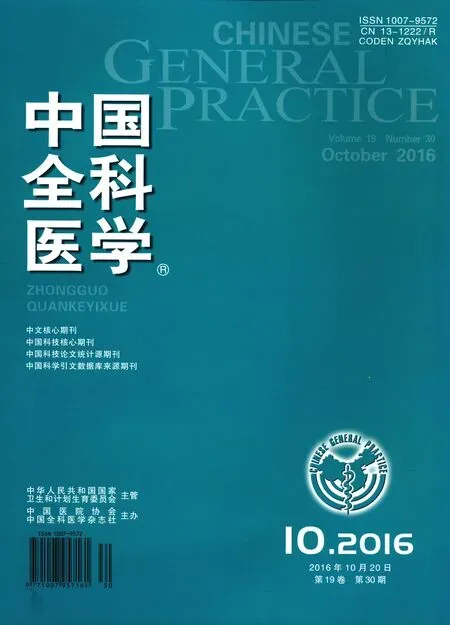男性睾酮水平及中老年男性雄激素部分缺乏综合征患病率分析
陈 坚,潘钦石,王瑜敏,周星星
·论著·
男性睾酮水平及中老年男性雄激素部分缺乏综合征患病率分析
陈 坚,潘钦石,王瑜敏,周星星
背景随着男性年龄增长,下丘脑-垂体-性腺轴功能逐渐衰退,因睾酮缺乏造成的中老年男性雄激素部分缺乏综合征(PADAM)会导致腹部肥胖、2型糖尿病、代谢综合征、心血管疾病、骨骼肌肉质量下降、性功能减退、情绪抑郁和认知障碍等。目的探讨男性睾酮水平及PADAM患病率变化。方法收集2011—2014年于温州医科大学附属第一医院体检的符合纳入标准的健康男性5 743例为研究对象。按照年龄分为20~岁组(142例)、30~岁组(1 261例)、40~岁组(2 346例)、50~岁组(1 339例)、60~岁组(552例)、70~85岁组(103例)。检测并记录所有研究对象睾酮水平。以20~岁组P10睾酮水平(11.1 nmol/L)作为阈值来判断PADAM患病率。结果研究对象睾酮水平为15.14(16.87,25.05)nmol/L,年平均PADAM患病率为16.8%。睾酮水平与年龄呈负相关(rs=-0.041,P=0.002)。30~岁组、40~岁组、50~岁组、60~岁组、70~85岁组睾酮水平均低于20~岁组(P<0.05)。6个年龄组睾酮水平年平均下降率为1.3%。30~岁组、40~岁组、50~岁组2011、2012、2013年睾酮水平均高于2014年(P<0.05)。30~岁组睾酮水平年平均下降率为1.7%;40~岁组、50~岁组睾酮水平年平均下降率分别为1.5%、3.0%。各年龄组PADAM患病率比较,差异无统计学意义(P>0.05)。50~岁组2011、2012、2013年PADAM患病率均低于2014年(P<0.05)。50~岁组PADAM患病率随时间呈上升趋势(P<0.05)。Logistic回归分析结果显示,年份是PADAM患病率的影响因素(P<0.05)。结论温州地区健康男性睾酮水平随年龄增长缓慢下降,30~59岁男性睾酮水平随年龄升高逐步下降,50岁后睾酮水平相对平稳;50~59岁男性的PADAM患病率随年份逐渐升高。
睾酮;中老年男性雄激素部分缺乏综合征;男人
陈坚,潘钦石,王瑜敏,等.男性睾酮水平及中老年男性雄激素部分缺乏综合征患病率分析[J].中国全科医学,2016,19(30):3685-3690.[www.chinagp.net]
CHEN J,PAN Q S,WANG Y M,et al.Testosterone level in men and prevalence of partial androgen deficiency in the aging male[J].Chinese General Practice,2016,19(30):3685-3690.
睾酮对于男性的性发育、精子产生和性欲起着关键性调节作用。30岁以后男性睾酮分泌水平开始减退,睾酮水平将随着身体衰老而降低[1]。有文献报道,中老年男性睾酮水平年平均下降0.8%[1-2]。随着睾酮水平的下降,男性出现系列病理症状,如腹部肥胖、糖尿病和糖尿病前期(如胰岛素抵抗、糖耐量减低、代谢综合征)、血脂异常、骨骼和肌肉质量下降、性功能减退、情绪抑郁和认知障碍等[3-4]。睾酮分泌受下丘脑-垂体-性腺轴的调节,发达国家已经开展了许多关于中老年男性雄激素及其相关影响因素的研究,但对中老年男性雄激素部分缺乏综合征(PADAM)的诊断和外源性补充治疗的阈值仍存在争议,特别是国家和地区人群差异导致PADAM缺乏一个普遍被接受的界定阈值[5]。近年来我国老龄化趋势加重,但国内相关研究还处于起步阶段[6]。本研究通过检测温州地区健康男性睾酮水平,初步分析健康男性睾酮水平的变化趋势,并探讨PADAM患病率及其可能机制,为临床诊断和治疗工作提供依据和基础。
1 资料与方法
1.1纳入与排除标准纳入标准:(1)20岁及以上男性;(2)无自诉的慢性病(糖尿病、高血压、心脏病、癌症等);(3)近期没有服用已知会影响下丘脑-垂体-性腺轴的处方药物(睾酮、抗雄激素、糖皮质激素、阿片类药物、抗癫痫药、抗精神病药物、5α还原酶抑制剂或芳香化酶抑制剂等);(4)无生殖系统手术史。排除标准:临床资料缺失患者。
1.2研究对象收集2011—2014年于温州医科大学附属第一医院体检的符合纳入标准的健康男性5 743例为研究对象。年龄20~85岁。按照年龄分为20~岁组(142例)、30~岁组(1 261例)、40~岁组(2 346例)、50~岁组(1 339例)、60~岁组(552例)、70~85岁组(103例)。研究对象均签署知情同意书,本研究通过本院伦理委员会审批。
1.3检测睾酮水平所有研究对象过夜禁食8 h以上,次日08:00~10:00抽血5 ml,3 500 r/min离心5 min(离心半径14 cm),取血清检测。采用Beckman Coulter公司Unicel DXI 800全自动微粒子化学发光免疫分析仪及睾酮试剂盒检测睾酮水平。睾酮试剂盒灵敏度为0.01 nmol/L,批内变异系数为3.93%,批间变异系数为7.08%。

2 结果
2.1一般情况研究对象睾酮水平为15.14(16.87,25.05)nmol/L,年平均PADAM患病率为16.8%。
2.2睾酮水平分析
2.2.1相关性分析睾酮水平与年龄呈负相关(rs=-0.041,P=0.002)。
2.2.2不同年龄组睾酮水平比较各年龄组睾酮水平比较,差异有统计学意义(P<0.05);其中30~岁组、40~岁组、50~岁组、60~岁组、70~85岁组睾酮水平均低于20~岁组,差异有统计学意义(P<0.05,见表1)。20~岁组到40~岁组睾酮水平呈梯度性下降,50~岁组睾酮水平稍提高,后3个年龄组睾酮水平维持相对稳定,6个年龄组睾酮水平年平均下降率为1.3%(见图1)。
2.2.3各年龄组不同年份睾酮水平比较20~岁组、60~岁组、70~85岁组不同年份睾酮水平比较,差异均无统计学意义(P>0.05)。30~岁组、40~岁组、50~岁组不同年份睾酮水平比较,差异均有统计学意义(P<0.05);其中30~岁组、40~岁组、50~岁组2011、2012、2013年睾酮水平均高于2014年,差异有统计学意义(P<0.05,见表2)。30~岁组2011—2014年睾酮水平逐年下降,睾酮水平年平均下降率为1.7%(见图2);40~岁组、50~岁组2011、2012年睾酮水平相对稳定,2013、2014年睾酮水平逐渐下降,睾酮水平年平均下降率分别为1.5%、3.0%(见图3、4)。
2.3PADAM患病率分析2.3.1不同年龄组PADAM患病率比较各年龄组PADAM患病率比较,差异无统计学意义(P>0.05,见表1)。

表1各年龄组睾酮水平和PADAM患病率比较
Table1ComparisonoftestosteronelevelandprevalenceofPADAMamongallagegroups
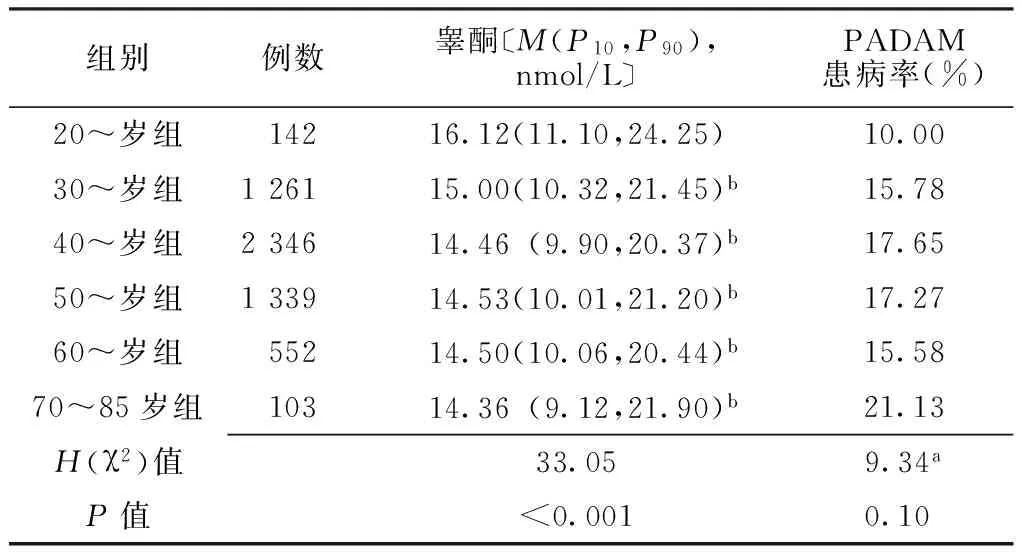
组别例数睾酮〔M(P10,P90),nmol/L〕PADAM患病率(%)20~岁组14216.12(11.10,24.25)10.0030~岁组126115.00(10.32,21.45)b15.7840~岁组234614.46(9.90,20.37)b17.6550~岁组133914.53(10.01,21.20)b17.2760~岁组55214.50(10.06,20.44)b15.5870~85岁组10314.36(9.12,21.90)b21.13H(χ2)值33.059.34aP值<0.0010.10
注:PADAM=中老年男性雄激素部分缺乏综合征,a为χ2值;与20~岁组比较,bP<0.05
2.3.3PADAM患病率影响因素的Logistic回归分析以PADAM患病情况(赋值:未患病=0,患病=1)为因变量,以年龄(赋值:20~岁组=1,30~岁组=2,40~岁组=3,50~岁组=4,60~岁组=5,70~85岁组=6)、年份(赋值:2011年=1,2012年=2,2013年=3,2014年=4)为自变量,进行Logistic回归分析,结果显示,年份是PADAM患病率的影响因素(P<0.05,见表3)。
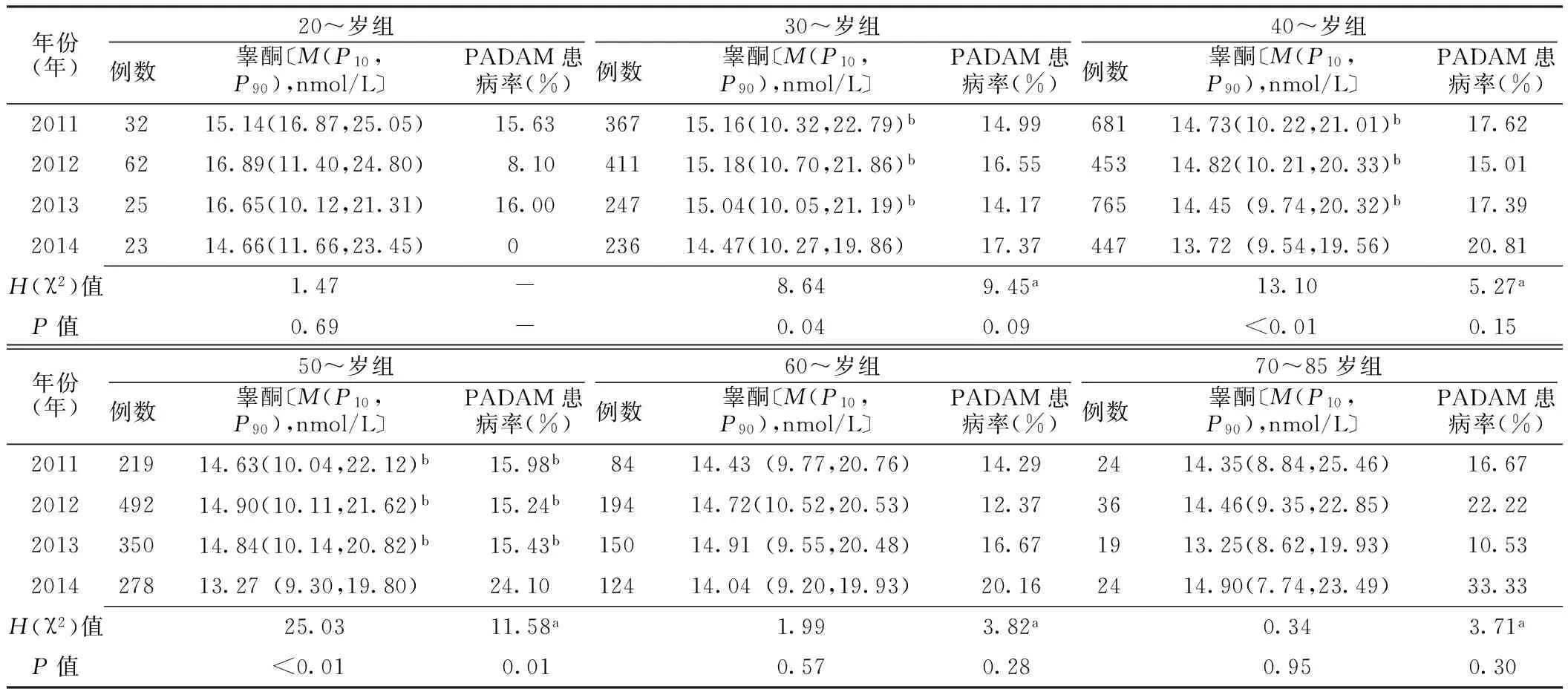
表2 各年龄组不同年份睾酮水平和PADAM患病率比较
注:a为χ2值,与同年龄组2014年比较,bP<0.05;-表示20~岁组2014年PADAM患病率为0,因样本量少未行统计学分析
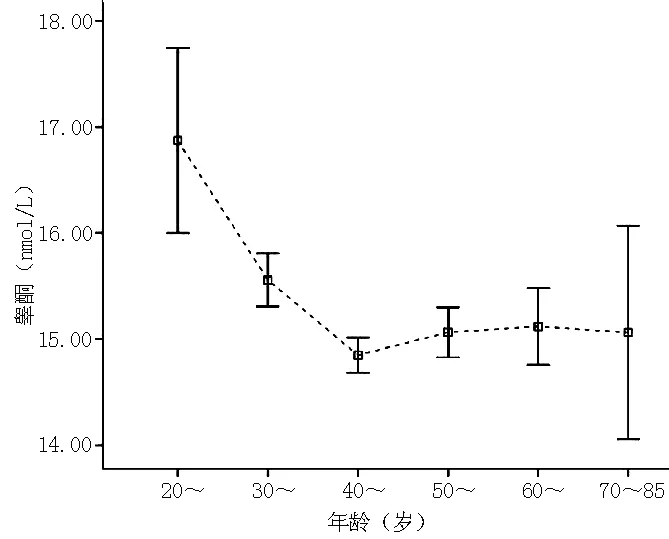
图1 睾酮水平随年龄的变化
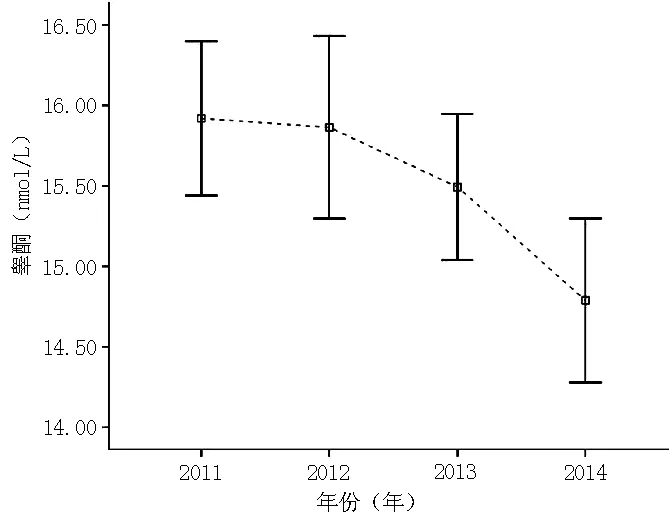
图2 30~岁组睾酮水平随年份的变化
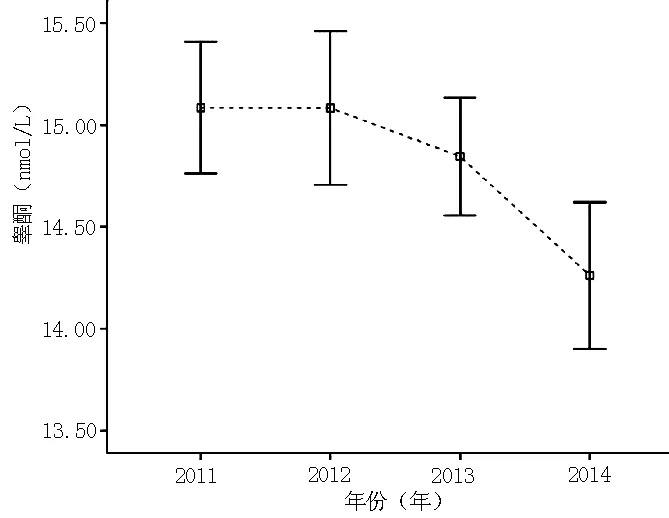
图3 40~岁组睾酮水平随年份的变化
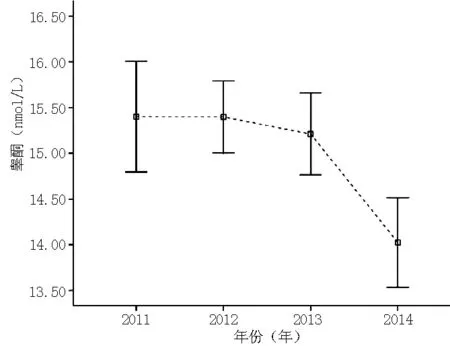
图4 50~岁组睾酮水平随年份的变化
Table 3Result of Logistic regression analysis on influencing factors for PADAM

变量βSEWaldχ2值P值OR值95%CI常数项-1.930.14194.49<0.001--年龄0.040.031.660.201.05(0.98,1.12)年份0.080.036.030.011.08(1.02,1.15)
注:-为无此项
3 讨论
近年来我国老龄化程度加重,迫切需要了解男性睾酮整体水平的变化趋势及其影响因素。但国内对PADAM研究处于初级阶段[6],缺乏大样本的横断面研究和纵向研究。本研究通过对温州地区5 743例20~85岁健康男性睾酮水平的分析发现,中位睾酮水平为15.14(16.87,25.05)nmol/L,与上海地区1 093例调查对象睾酮水平比较接近[6],但均低于美国白人和华人[8]。PADAM年平均患病率为16.8%,国内尚未见相关报道。
睾酮是男性的主要雄激素,95%睾酮由睾丸间质细胞分泌,5%由肾上腺分泌,受下丘脑-垂体-睾丸轴调节。随着年龄增长,下丘脑-垂体-睾丸轴的各级变化均可导致睾酮分泌减少。横向研究和纵向研究均已经表明,随着衰老男性群体的血清睾酮水平出现下降[9-11]。本研究结果显示,横向比较,6个年龄组睾酮水平年平均下降率为1.3%,高于FELDMAN等[11]报道的0.8%,与南京地区变化相似[12];纵向比较,30~岁组、40~岁组、50~岁组2011、2012、2013年睾酮水平均高于2014年;30~岁组2011—2014年睾酮水平逐年下降,睾酮水平年平均下降率为1.7%;40~岁组、50~岁组2011、2012年睾酮水平相对稳定,2013、2014年睾酮水平逐渐下降,睾酮水平年平均下降率为1.5%。FELDMAN等[11]研究显示,40~70岁男性睾酮年平均下降率为1.6%,且国内缺乏相关数据。可能是男性睾丸分泌功能逐年衰竭,导致睾酮分泌水平减少,30~50岁男性性腺功能衰老加重。此现象可能与当前中老年男性生活习惯等相关,应引起社会的高度重视。
国内外学者建议以睾酮11 nmol/ L作为阈值来诊断PADAM[5,7]。本研究以20~岁组P10睾酮水平(11.1 nmol/L)作为阈值来判断PADAM,结果显示,30~岁组患病率为15.78%,40~岁组患病率为17.65%,50~岁组患病率为17.27%,60~岁组患病率为15.58%,70~85岁组患病率为21.13%,高于国外文献报道的6%[13]。但是本研究结果显示,各年龄组PADAM患病率无差异,20~岁组、30~岁组、40~岁组、60~岁组、70~85岁组不同年份PADAM患病率无差异;Logistic回归分析结果显示,年份是PADAM患病率的影响因素;而50~岁组2011、2012、2013年PADAM患病率均低于2014年,50~岁组PADAM患病率随时间呈上升趋势。PADAM患病率越来越高,但临床医生在诊断和治疗PADAM中存在挑战,因为PADAM的症状是非特异性和多变的,实验室的参考范围和判断下限存在区域差异,因此只有12%有临床症状的性腺功能减退男性得到睾酮补充治疗[14-15]。
睾酮水平随年龄的变化趋势仍存在争议[7,16-17]。本研究结果显示,睾酮水平与年龄呈负相关,与南京地区报道结果一致[12],但李江源等[7]发现,睾酮水平与年龄无相关性;同时国外研究结果也不尽相同[16-17]。本研究结果显示,30~岁组、40~岁组、50~岁组、60~岁组、70~85岁组睾酮水平均低于20~岁组,20~岁组到40~岁组睾酮水平呈梯度性下降,50~岁组睾酮水平稍提高,后3个年龄组睾酮水平维持相对稳定。有研究表明,促黄体生成素(LH)水平随年龄增长而升高[6],笔者推测,50岁后LH水平增长反馈刺激睾酮代偿性分泌。YEAP等[18]研究显示,70~89岁男性总睾酮水平不随年龄增长而下降,睾酮水平与年龄反而呈较弱的正相关。周善杰等[19]在河北的调查也显示,中老年男性血清睾酮水平随年龄增长无明显改变。KELSEY等[20]分析了多项研究的10 097例数据,并未发现任何证据支持中老年男性睾酮水平随年龄逐步下降。
游离睾酮水平能更好地代表睾酮的生物活性及反应机体雄激素的变化,但因其检测繁琐临床不宜推广,本研究并未检测游离睾酮水平;有资料表明,中老年男性睾酮水平低下者使用睾酮替代疗法可明显改善代谢综合征和心血管疾病的症状[21],而本研究对中老年男性体内睾酮水平与血糖、血脂的变化缺乏深入研究,后续将进一步研究其他激素、血糖、血脂、体质量和生活习惯等与睾酮水平的关联。
综上所述,温州地区健康男性血清睾酮水平随年龄增长缓慢下降,30~59岁男性睾酮水平随年份逐步下降,50岁后睾酮水平相对平稳;50~59岁男性的PADAM患病率随年份逐渐升高。
作者贡献:陈坚、潘钦石、王瑜敏进行试验设计与实施、资料收集整理、撰写论文、成文并对文章负责;周星星进行试验实施、评估、资料收集;陈坚进行质量控制及审校。
本文无利益冲突。
[1]WU F C,TAJAR A,PYE S R,et al.Hypothalamic-pituitary-testicular axis disruptions in older men are differentially linked to age and modifiable risk factors:the European Male Aging Study[J].J Clin Endocrinol Metab,2008,93(7):2737-2745.
[2]ORWOLL E,LAMBERT L C,MARSHALL L M,et al.Testosterone and estradiol among older men[J].J Clin Endocrinol Metab,2006,91(4):1336-1344.
[3]SHORES M M,SMITH N L,FORSBERG C W,et al.Testosterone treatment and mortality in men with low testosterone levels[J].J Clin Endocrinol Metab,2012,97(6):2050-2058.
[4]ZIRKIN B R,TENOVER J L.Aging and declining testosterone:past,present,and hopes for the future[J].J Androl,2012,33(6):1111-1118.
[5]VERMEULEN A.Hormonal cut-offs of partial androgen deficiency:a survey of androgen assays[J].J Endocrinol Invest,2005,28(3 Suppl):28-31.
[6]LIU Z,LIU J,SHI X,et al.Dynamic alteration of serum testosterone with aging:a cross-sectional study from Shanghai,China[J].Reprod Biol Endocrinol,2015,13:111.
[7]李江源,李小鹰,李明,等.血清游离睾酮水平和睾酮分泌指数随年龄老化而降低[J].中华男科学杂志,2006,12(6):555-558.
[8]SANTNER S J,ALBERTSON B,ZHANG G Y,et al.Comparative rates of androgen production and metabolism in Caucasian and Chinese subjects[J].J Clin Endocrinol Metab,1998,83(6):2104-2109.
[9]HARMAN S M,METTER E J,TOBIN J D,et al.Longitudinal effects of aging on serum total and free testosterone levels in healthy men.Baltimore Longitudinal Study of Aging[J].J Clin Endocrinol Metab,2001,86(2):724-731.
[10]TRAVISON T G,ARAUJO A B,KUPELIAN V,et al.The relative contributions of aging,health,and lifestyle factors to serum testosterone decline in men[J].J Clin Endocrinol Metab,2007,92(2):549-555.
[11]FELDMAN H A,LONGCOPE C,DERBY C A,et al.Age trends in the level of serum testosterone and other hormones in middle-aged men:longitudinal results from the Massachusetts male aging study[J].J Clin Endocrinol Metab,2002,87(2):589-598.
[12]卿兴荣,王玲玲,王国洪,等.南京城区中老年男性生殖激素及相关指标分析[J].中华男科学杂志,2014,20(4):347-353.
QING X R,WANG L L,WANG G H,et al.Reproductive hormone levels and relevant parameters in middle-aged and older men in the urban area of Nanjing[J].National Journal of Andrology,2014,20(4):347-353.
[13]ARAUJO A B,O′Donnell A B,BRAMBILLA D J,et al.Prevalence and incidence of androgen deficiency in middle-aged and older men:estimates from the Massachusetts Male Aging Study[J].J Clin Endocrinol Metab,2004,89(12):5920-5926.
[14]BHASIN S,ZHANG A,COVIELLO A,et al.The impact of assay quality and reference ranges on clinical decision making in the diagnosis of androgen disorders[J].Steroids,2008,73(13):1311-1317.
[15]MCGILL J J,SHOSKES D A,SABANEGH E S.Androgen deficiency in older men:indications,advantages,and pitfalls of testosterone replacement therapy[J].Cleve Clin J Med,2012,79(11):797-806.
[16]SHI Z,ARAUJO A B,MARTIN S,et al.Longitudinal changes in testosterone over five years in community-dwelling men[J].J Clin Endocrinol Metab,2013,98(8):3289-3297.
[17]FROST M,WRAAE K,NIELSEN T L,et al.Similar reference intervals for total testosterone in healthy young and elderly men:results from the Odense Androgen Study[J].J Clin Endocrinol (Oxf),2013,78(5):743-751.
[18]YEAP B B,ALMEIDA O P,HYDE Z,et al.In men older than 70 years,total testosterone remains stable while free testosterone declines with age.The Health in Men Study[J].Eur J Endocrinol,2007,156(5):585-594.
[19]周善杰,卢文红,袁冬,等.河北某地社区中老年健康男性血清生殖激素水平变化研究[J].中华男科学杂志,2009,15(8):679-684.
ZHOU S J,LU W H,YUAN D,et al.Changes of serum reproductive hormones with aging among healthy males in a community population of hebei province[J].National Journal of Andrology,2009,18(5):679-684.
[20]KELSEY T W,LI L Q,MITCHELL R T,et al.A validated age-related normative model for male total testosterone shows increasing variance but no decline after age 40 years[J].PLoS One,2014,9(10):e109346.
[21]KANG H Y.Beyond the male sex hormone:deciphering the metabolic and vascular actions of testosterone[J].J Endocrinol,2012,217(3):C1-3.
(本文编辑:崔丽红)
Testosterone Level in Men and Prevalence of Partial Androgen Deficiency in the Aging Male
CHENJian,PANQin-shi,WANGYu-min,ZHOUXing-xing.
CenterforClinicalLaboratory,theFirstAffiliatedHospitalofWenzhouMedicalUniversity,Wenzhou325000,China
Correspondingauthor:CHENJian,CenterforClinicalLaboratory,theFirstAffiliatedHospitalofWenzhouMedicalUniversity,Wenzhou325000,China;E-mail:knacl123@163.com
BackgroundThe hypothalamic-pituitary-gonadal axis function gradually declined with increasing age in men.Partial Androgen Deficiency in the Aging Male(PADAM) mainly testosterone deficiency caused abdominal obesity,type 2 diabetes mellitus,metabolic syndrome,cardiovascular disease,decreased bone and muscle strength and quality,sexual dysfunction,depression,and cognitive disorders.ObjectiveTo investigate the change of testosterone level in men and the prevalence of PADAM.MethodsA total of 5 743 heathy men who accepted routine examination from the First Affiliated Hospital of Wenzhou Medical University from 2011 to 2014 and met the inclusion criteria were collected.All subjects were divided into 6 groups,including 20- years old group (142 cases),30- years old group (1 261 cases),40- years old group (2 346 cases),50- years old group (1 339 cases),60- years old group (552 cases) and 70-85 years old group (103 cases).Testosterone level in all subjects was measured and recorded.Testosterone level (11.1 nmol/L) in 20- years old group was suggested to be a threshold for the diagnosis of PADAM.ResultsTestosterone level was 15.14 (16.87,25.05) nmol/L in all subjects,the average annual prevalence of PADAM was 16.8%.Testosterone level was negatively correlated with age (rs=-0.041,P=0.002).Testosterone level in 30- years old group,40- years old group,50- years old group,60- years old group and 70-85 years old group was significantly lower than that in 20- years old group (P<0.05).The average annual decline rate of testosterone level in 6 groups was 1.3%.Testosterone level in 30- years old group,40- years old group and 50- years old group in 2011,2012,2013 was higher than that in 2014 (P<0.05).The average annual decline rate of testosterone level in 30- years old group was 1.7%;the average annual decline rate of testosterone level in 40- years old group and 50- years old group was 1.5% and 3.0%,respectively.There was no significant difference in the prevalence of PADAM among all age groups (P>0.05).The prevalence of PADAM of 50- years old group in 2011,2012,2013 was lower than that in 2014 (P<0.05).The prevalence of PADAM in 50- years old group showed a trend of increase with time (P<0.05).Logistic regression analysis showed that year was the influence factor of PADAM prevalence (P<0.05).ConclusionTestosterone level gradually decreased with age increasing in healthy Wenzhou male.Testosterone level in 30-59 years old male gradually declined with age increasing.Testosterone level was relatively stable after 50 years old.The prevalence of PADAM in 50-59 years old men gradually increased year by year.
Testosterone;Partial androgen deficiency in the aging male;Man
温州市科技局科技计划项目(Y20140032)
325000 浙江省温州市,温州医科大学附属第一医院医学检验中心
陈坚,325000 浙江省温州市,温州医科大学附属第一医院医学检验中心;E-mail:knacl123@163.com
R 347.911
A
10.3969/j.issn.1007-9572.2016.30.009
2016-02-02;
2016-07-08)

